Reviews by Team: Nonprofit Media
We look for quality sources of news and analysis in the public interest
In November 2015, Nathan Robinson and Oren Nimni launched a Kickstarter to fund the creation of Current Affairs, a print magazine of “political analysis, satire, and entertainment” promising to “make life joyful again”. The campaign exceeded its goal of $10,000. Three years later, Current Affairs has become of the most reliably interesting and, indeed, enjoyable political publications on the left.
Print editions are issued every two months; each is carefully designed and, in addition to articles on diverse topics, every issue contains the creative works of many contributing artists. While many illustrations simply support a given article, in other cases it’s the illustrations that tell the story—see, for example, the “City of Dreams” illustration and accompanying article.

Recent Current Affairs covers. (Credit: Current Affairs. Fair use.)
Chances are that you’ve come across Current Affairs articles before through some of Nathan Robinson’s in-depth “takedown” articles about prominent American and Canadian political writers — especially those spreading reactionary ideas, e.g., Ben Shapiro, Charles Murray, Sam Harris, Jordan Peterson, Mike Cernovich, and Dinesh D’Souza.
Instead of simply dismissing them outright, Robinson takes these figures to account on the basis of their own words, dissecting the ugly mess of hateful nonsense beneath whatever persona they’ve created for themselves.
Current Affairs is a decidedly leftist publication; it routinely condemns capitalist excess, corporate misconduct, “bipartisan” alliances with murderous regimes, the convenient political amnesia concerning America’s history of horrific military interventions, the dark legacy of racism at the root of deep social and economic inequalities.
While it writes of socialism as a political and economic alternative, the magazine has been equally critical of authoritarian socialism. Robinson’s own essay, “How To Be A Socialist Without Being An Apologist For The Atrocities Of Communist Regimes“, puts it quite plainly:
The dominant “communist” tendencies of the 20th century aimed to liberate people, but they offered no actual ethical limits on what you could do in the name of “liberation.” That doesn’t mean liberation is bad, it means ethics are indispensable and that the Marxist disdain for “moralizing” is scary and ominous.
Current Affairs instead leans towards libertarian socialism, an ideology seeking to balance a high commitment to individual freedom with a concern for the welfare of societies. It speaks of “humanistic” values and holds all ideologies to account for living up to those values.
The magazine publishes essays about diverse topics from the changing politics of Star Trek to the Mardi Gras holiday in New Orleans. You’re in for a visual treat the moment you open the table of contents, each of which is an artistic exploration of the topics covered in the current edition.
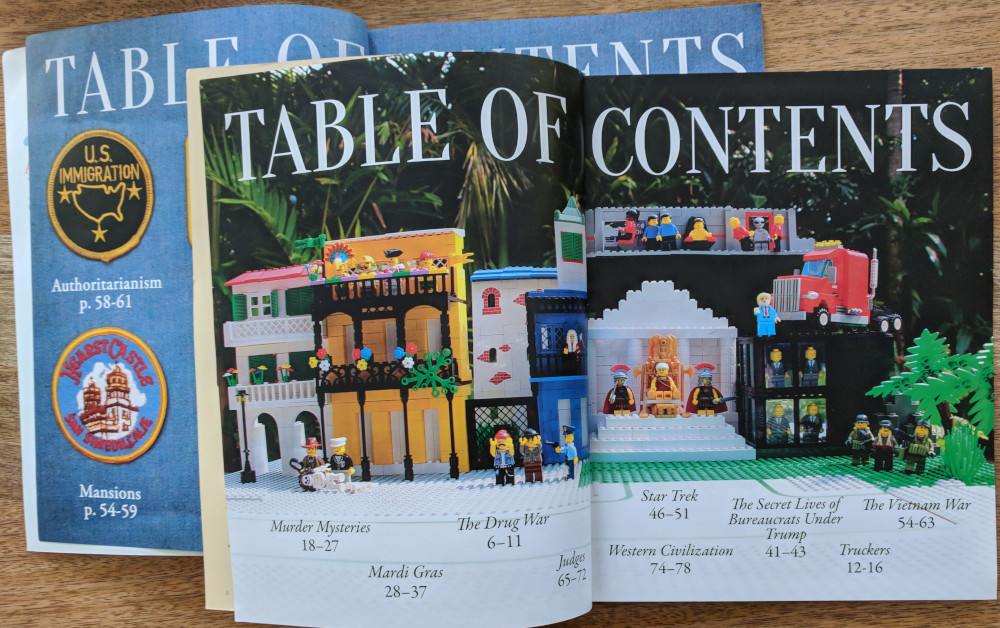
Current Affairs table of contents examples. (Credit: Current Affairs. Fair use.)
Alongside its playfulness and occasional silliness, the magazine features articles such as a gut-wrenching and unflinching look back at the Vietnam War (“What We Did”) or an insightful report on disillusioned African-American Rust Belt voters (“The Color of Economic Anxiety”).
Recently, the magazine also launched a podcast; as of this writing, it is already generating more than $6,000/month in Patreon support (supporters get access to bonus episodes). The podcast features conversations between the magazine’s contributors on a wide variety of topics, featuring segments like “Lefty Shark-Tank” (tongue-in-cheek criticism of left-wing policy ideas), interviews, answers to listeners, parody ads, and more.
Legally, Current Affairs is not a nonprofit; Nathan Robinson told me by email that the team “debated it and then decided against it as it creates all kinds of logistical headaches”.
However, he emphasized that Current Affairs will never operate as a for-profit company. Over the course of each magazine’s two-month run, all articles are published online without any kind of paywall, and the website and magazine are entirely free of third party ads. Regrettably, articles are under conventional copyright, as opposed to a permissive Creative Commons license.

Article example from the latest issue. (Credit: Current Affairs. Fair use.)
The Verdict
After reading their online edition for a while, I subscribed to Current Affairs earlier this year, and have not regretted it yet. At $60 for 6 issues, you get good value for your money; the magazine is a pleasure to look at, and I generally read it all the way through before the next one arrives.
A few typos usually slip through, and some articles would benefit from more rigor (data, citations) or additional editing. But these are the kinds of problems you would expect from a small, independent magazine.
In many ways, I prefer the Current Affairs model to the heavily grant-funded nonprofit publications I’ve reviewed (e.g., The Marshall Project, ProPublica). It will likely never be able to muster the resources to engage in a similar scale of reporting projects, but its writing is fearless and independent, funded entirely by readers. While its humor can be snarky, underneath it there’s an earnestness that’s disarming and likable. I highly recommend checking it out.
Would you enjoy reading it? Fortunately, that’s easy to find out by browsing the archives of the website. Regardless of its legal status, I’ve also added it to the Twitter feed of quality nonprofit media, which is a convenient way to sample the content of many nonprofit outlets if you happen to use Twitter.
Quanta Magazine is one of two websites published by the Simons Foundation, the vehicle for hedge fund founder James Simons’ philanthropic giving. Quanta focuses on mathematics, physics, computer science and biology. The other publication is Spectrum News, which covers autism research.
The Simons Foundation had more than $2B in net assets as of its 2015 tax return; Quanta is essentially one of its gifts to the public and does not rely on additional support. This makes it similar to Mosaic (reviews), published by the even more massively endowed Wellcome Trust. However, it publishes a lot more frequently: Mosaic tends to publish 2-4 long-form articles per month; Quanta publishes more than a dozen medium-sized articles in the same timeframe.
Financial background
The name Quanta evokes the source of James Simons’ $18.5B fortune: quant investing. Simons, who worked as an NSA codebreaker at age 26, has been described as “the mathematician who cracked Wall Street” for his use of highly sophisticated mathematical models to predict profitable trades. His personal wealth derives from his hedge fund, Renaissance Technologies, which the MIT’s Andrew Lo called the “pinnacle of quant investing” and “the commercial version of the Manhattan Project”.
In 2014, Renaissance was interrogated by the US Senate for the use of an obscure loophole to avoid an estimated $6.8B in capital gains tax, an amount which far exceeds the endowment of the Simons Foundation. Its name has made the news for another reason: Renaissance co-CEO Robert Mercer is one of the biggest backers of Donald Trump’s anti-science Presidency and of the far right, anti-intellectual propaganda outlet Breitbart News, while Simons himself backed Hillary Clinton.
While the philanthropic impulses of the company’s principals are clearly contradictory, Quanta’s editorial beat is unlikely to conflict with Renaissance’s financial origins. Quanta itself has this to say about its editorial independence:
All editorial decisions, including which research or researchers to cover, are made by Quanta’s staff reporting to the editor in chief; editorial content is not reviewed by anyone outside of the news team prior to publication; Quanta has no involvement in any of the Simons Foundation’s grant-giving or research efforts; and researchers who receive funding from the foundation do not receive preferential treatment. The decision to cover a particular researcher or research result is made solely on editorial grounds in service of our readers.
Scope, design, navigation
Quanta’s stated goal is to “illuminate science”. In practice, this translates to articles that seek to arouse curiosity rather than controversy.
Where a magazine like Mosaic doesn’t shy away from in-depth articles about abortion rights in India and the US or sex workers in Mozambique, Quanta tends to write about questions in science that are both interesting and not highly politicized. Over a five-year period, I only found two feature articles with a strong political dimension: “A Physicist Who Models ISIS and the Alt-Right” and “How to Quantify (and Fight) Gerrymandering”. Zero articles about abortion, zero about transgender or homosexuality, one whose primary topic is climate change.
This is not a criticism; there surely is a place for a publication like this, which may succeed in reaching people across the political spectrum and promote a greater interest in science itself. Indeed, for the topics it does tackle, Quanta often succeeds spectacularly at making complex topics accessible and interesting.
This starts with the website design: Quanta is easily one of the most beautiful sites we’ve reviewed. The design leaves a lot of room for large-format images, while scaling well onto mobile devices, as well. Careful use of typography, color and whitespace gives the articles an aesthetic that brings together elements of print and the web in a very appealing manner.
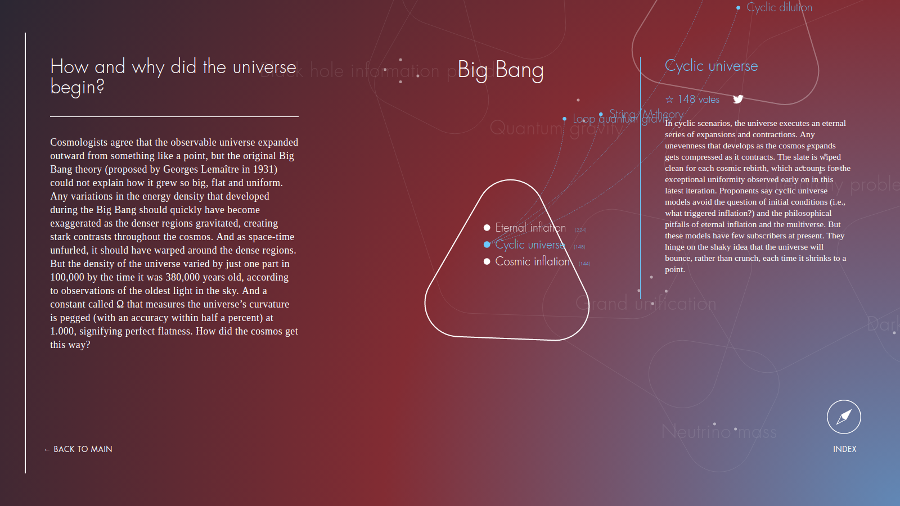
Quanta sometimes publishes interactive micro-sites, such as this explorable (and information-rich) map of current contenders for a “Theory of Everything” (Credit: Quanta Magazine. Fair use.)
Alongside recent articles and features, the front page highlights videos, podcasts, most-read articles, and “recommended features” (which includes articles from previous years). Individual pages include tags like “Microbiology” or “Podcast”. Overall the site is easy to navigate. Most content loads without JavaScript enabled, though some site features will break and leave behind empty boxes.
Content examples
Quanta’s reporting on bacteria and biofilms is illustrative of how it approaches complex topics. The feature story, “Bacteria Use Brainlike Bursts of Electricity to Communicate”, recaps well-understood principles of chemical communication in bacterial colonies, and adds recent findings regarding ion channel communication.
The story is supported by quotes from multiple scientists (five from the United States, one from Spain and one from Italy). It includes a GIF animation that was carefully adapted from YouTube videos published by one of the scientist teams. The writing and approach is similar to Scientific American. In fact, the article was also syndicated to its website, and the author has bylines there and in other science magazines.
Quanta published a related feature titled “Seeing the Beautiful Intelligence of Microbes”, which shows many more examples of biofilm and slime mold behavior, again often employing large format GIF animations. This underscores the magazine’s willingness to go beyond the limitations of a print magazine. It’s a visually stunning feature that even readers with limited scientific interest may enjoy.

Expansion of Pseudomonas biofilm, an example of the kind of carefully produced GIF animation that makes many Quanta articles visually outstanding (Credit: Quanta Magazine. Fair use.)
A more elaborate example is Quanta’s 2015 map of “theories of everything”. It’s an interactive full screen overview of physics concepts like loop quantum gravity and the holographic principle, organized into the larger and overlapping areas of knowledge they relate to. This is the kind of resource you may end up returning to as you read about these topics in the news.
Some Quanta articles are accompanied by podcast episodes. Episodes are featured as a prominent “play” button at the top of a regular article for the relevant episode, which looks like an effective way to draw in listeners who don’t typically subscribe to podcasts.
There is also a YouTube channel. As with many other nonprofit publications, it reaches a relatively small audience of less than 10,000 subscribers, though some of the educational videos (e.g., “What is a species?”) are quite good. There are many education/science YouTube channels with orders of magnitude more subscribers, so perhaps a partnership would be more successful at reaching a large audience.
Licensing
Quanta articles are frequently syndicated to other publications. They are under conventional copyright; in response to an inquiry, a staff member stated that there are no plans to consider a Creative Commons license. This is regrettable: much of the text, image and video content would be useful for open educational resources.
Like Mosaic, Quanta’s funding is secure thanks to a large endowment; it’s not clear why an open access license is off the table. As it is, we can enjoy Quanta for free, but we cannot re-use it and build on it without permission. It is a gift, but one with strings attached.
The Verdict
Quanta succeeds in its mission of making scientific topics accessible, often in a way that inspires further exploration and learning. It’s a beautiful website that makes good use of the web as a medium–through animations, large format photographs, videos, interactives, well-integrated podcasts, and so on.
I recommend following Quanta’s work to any curious person. While I would love to see it under a Creative Commons license, this does not impact the rating per our standard criteria. 5 out of 5 stars.
In the social and political upheaval of the 1960s and 1970s, many socialist and progressive publications were born. Most are long gone; New Internationalist, founded in 1973 in the UK, is a notable exception. Not only has it survived well into the 21st century, it has proven its adaptability through a crowdfunding campaign that raised more than $900K in donations.
Through its history, the publication has focused on liberation and decolonization movements around the world and on the global impact of unbridled capitalism. It was one of the first publications to highlight the dangers of Nestlé’s efforts to market infant formula milk in the developing world; decades later, it played a similar role in raising awareness of fracking.
A significant part of New Internationalist’s ethos is to “give space for people to tell their
own stories”, that is, to feature international writers instead of Western “experts” and correspondents. This helps to lend an authenticity to its reporting that many other publications lack.

The provocative April 1982 cover of New Internationalist, revisiting the issue of infant formula milk.
New Internationalist also operates the Ethical Shop, which sells books, calendars, clothing, and various other merchandise. This includes original publications, such as the series of “No-Nonsense Guides” on topics ranging from global finance to drug legalization. Other products are sold together with partner charities. The shop follows a Buying Policy that seeks to promote good labor and environmental practices.
While it tends to support left-wing politics, New Internationalist is not an explicitly socialist magazine.
Finances, Transparency, Impact
Many of the US-based nonprofit media we have reviewed are dependent on grants, awarded from the fortunes amassed by the likes of Bill Gates, Michael Bloomberg, George Soros, Herbert Sandler, or previous generations of industrialists. This can create a bias towards elite audiences and away from highly contentious topics (see, e.g., Rodney Benson: Can foundations solve the journalism crisis?).
In contrast, the revenue supporting New Internationalist comes from people buying digital and print publications, or ordering other products from the Ethical Shop. This is broken down in percentages in the 2013/14 Annual Report, which does however not include GBP (£) figures. Indeed, the New Internationalist website includes no direct reference to organizational internals, and I did not receive a response to a contact inquiry asking for more recent information.
This lack of transparency is all the more regrettable given that the organization is run as a co-op with a non-hierarchical structure, very unlike the top-down model that is typical for US nonprofits. The rest of the world would benefit from learning more about this approach from those who practice it.
The UK Companies House report for New Internationalist Publications Ltd. shows net assets of 853K GBP (about 1.15M USD) as of March 31, 2016.
As of this writing, New Internationalist has about 37.8K followers on Twitter and about 80K on Facebook. These numbers should have some room to grow; consider, for example, that Positive News (also UK-based, also a co-op, with a smaller budget and smaller print circulation) has about 260K Facebook followers.
Design and Apps
The New Internationalist website is a minimalist feed of articles that mixes shorter posts and features, without any apparent prioritization beyond recency. Stories are tagged with regions and topics, which can be used to explore the large library of articles. The site is reasonably mobile-friendly. Some readers may have difficulty with the relatively low contrast color scheme (an unfortunate recent design trend).
As with many publications from the print era, only a subset of New Internationalist content is available for free online. If you prefer digital over a print subscription, you can purchase and read the magazine on Android or iOS devices via the respective apps (New Internationalist for Android, New Internationalist for iOS).
The Android app works well enough, though there are a few annoyances; for example, wide tables require horizontal scrolling, but accidental “swipe” gestures trigger moving from one article to the next, making it almost impossible to actually view wide tables. On the plus side, the article text is readable, and tables are presented as tables rather than as embedded images.
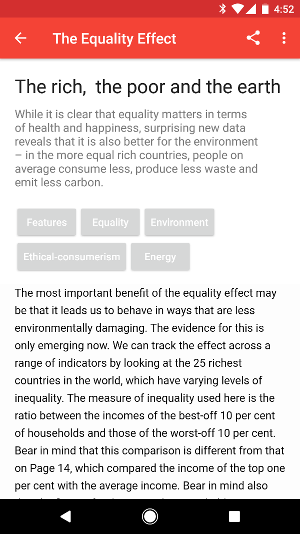
You can purchase full copies of the magazine via the Android and iOS apps.
An alternative to buying copies through the apps is purchasing them through Zinio and reading the magazine through its dedicated reader. As far as I can tell, there is no option to purchase and download DRM-free PDF files, and I found no evidence that any part of New Internationalist (web or app) is developed as open source software. New Internationalist articles are under conventional copyright (as opposed to a Creative Commons license).
Content Example: “The Equality Effect”
While not all content is available for free, many feature stories are posted in full. “The Equality Effect” is such a feature story, written by Danny Dorling, Professor of Geography at the University of Oxford and author of a book with the same title. In fact, much of the July issue was dedicated to the issue of inequality and edited by Dorling.
The article is analytical, making the case that inequality is the source of a large number of social ills, and not at all unavoidable. Rather than promoting a specific political ideology, Dorling is making a case to consider policies addressing inequality on their merits:
Although leftwing and green politicians tend to advocate greater equality more vocally, and rightwing and fascist ones tend to oppose it, equality is actually not the preserve of any political label. Great inequality has been sustained or increased under systems labelled as socialist and communist. Some free-market systems have seen equalities grow and the playing field become more level. Anarchistic systems can be either highly equitable or inequitable.
At the bottom of the article is a carousel of “related articles”, some from the same issue. It’s easy to miss that Dorling wrote another piece in the July issue expanding on his argument: “The rich, poor and the earth”. It cites additional data and attempts to show correlations between inequality and waste production, CO2 emissions, and meat consumption.
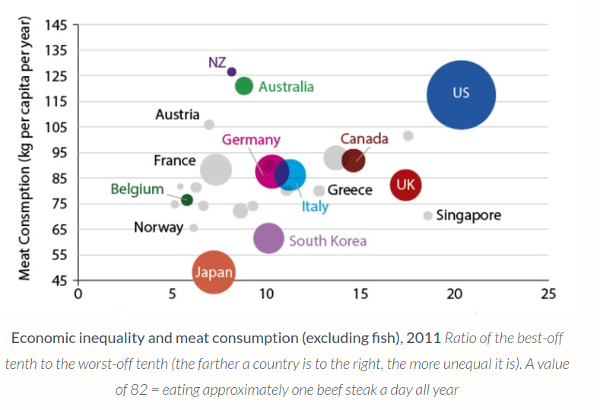
As presented, this chart does not support the thesis of the article that inequality is meaningfully correlated with meat consumption, let alone that there is a causal relationship.
Skeptical readers will find the analysis here to be lacking in rigor. Dorling dismisses outliers; in the case of the “meat consumption” chart, France, Germany, and the UK show very similar levels of meat consumption in spite of large differences in inequality. Eliminate the US and even the appearance of a correlation largely disappears; in any case, a correlation coefficient is not given.
With these kinds of charts, there are many ways to demonstrate the result you want: by cherry-picking countries, by picking the measure of inequality that shows the strongest correlation, and by only considering alternative explanations for data points that disagree with the hypothesis (“their cultural histories are bound up with the rearing of sheep and cattle”).
Data scientists warn that much more visually compelling spurious correlations can be found between many completely unrelated measures, and that even peer reviewed science is routinely subject to data dredging and p-hacking. “Science isn’t broken, it’s just a hell of a lot harder than we give it credit for,” warned a must-read article by FiveThirtyEight science writer Christie Aschwanden.
The thematic focus on inequality is laudable, and it makes sense that New Internationalist would invite an accomplished academic writer on this topic as guest editor. In fact, the much larger Guardian also published Dorling’s bubble chart analysis uncritically. Still, we should expect a greater level of empirical rigor in unpacking complex issues such as this one.
Content Example: “The Many Roots of Homelessness”
“Civil war, mental illness, poverty, gang violence: the many roots of homelessness” is a more conventional storytelling piece from the June issue that shares personal narratives of people experiencing homelessness and housing insecurity from the Philippines, Great Britain, the United States and, Mexico.
This short article showcases New Internationalist’s strength in featuring authentic voices from around the globe. For example, Maria from the Philippines describes the economic pressure which forces her family to live in a slum:
We found a room for rent in the nearby block. It cost $50 a month. It’s expensive and eats a huge chunk of Marvin’s monthly income of $119. I can’t work yet because I have to take care of our baby, Mark. So this is our home for now.
This kind of storytelling is crucial to overcome stereotypes and to challenge the stigma often associated with homelessness.
The Verdict
New Internationalist is important: it sheds light on underreported injustices and amplifies the voices of activists who seek to bring about positive change. As a left-wing publication, it occupies a relatively lonely space by taking an impact-oriented international view without being stridently ideological.
It has outlasted many other magazines and successfully made its way into the 21st century, but not without stumbling. The website and apps still have a few mostly minor bugs; the site design suffers from small readability issues and lacks clear organizing principles; the level of transparency is below some other mature nonprofits of similar size (compare Truthout’s timely and comprehensive Annual Reports, for example).
You will find many stories here that nobody else is covering, with larger ambition and reach than other publications we’ve reviewed, and the editorial quality is generally high. When tackling complex topics, New Internationalist would benefit from more rigorous internal review to ensure the highest possible quality of reporting. Recommended; 4 out of 5 stars.
Natural selection has equipped our species with brains that pay special attention to negative events. We monitor the world for threats to our well-being, and we enforce in-group social norms by ostracizing those who violate them.
Our modern media ecosystem kicks these reasonable sensitivities into overdrive and produces pathological feedback loops. A celebrity’s stupid offhand remark in an interview may trigger a multi-day cycle of outrage; a terrorist’s violent act may dominate collective attention for weeks.
This is not without consequences. We become vulnerable to manipulation and demagogy. We become polarized. We become depressed. Negativity spreads on its own. It is positive, constructive engagement with the world that takes effort.
Positive News wants to help. A public benefit co-operative based in London, owned by authors and readers, it’s both a print magazine and a website dedicated to what it terms “constructive journalism”. This isn’t about images of puppies (not that there’s anything wrong with those) or about seeing the world through rose-colored glasses. Instead, Positive News focuses on stories that show how difficult problems can be solved or at least chipped away at.
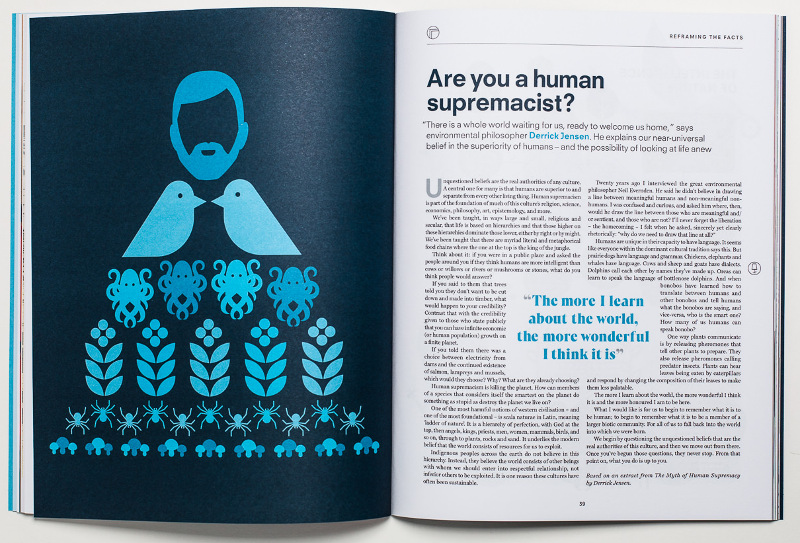
The magazine is beautifully designed, with appealing typography and layout, and large format photographs and illustrations
Background
Positive News has been around for a while. It was started as a quarterly newspaper in 1993 but was relaunched as a magazine by editor-in-chief Seán Dagan Wood in 2015. The crowdfunding campaign for the co-op raised £263K (about $340K). The co-ownership model is becoming increasingly popular in the UK — nonprofit magazine New Internationalist launched a similar campaign earlier this year and raised £704K.
As part of its crowdfunding campaign, Positive News published a business plan, which includes long-term revenue goals. I was not able to find public information about revenue and spending beyond the plan, and have not received a response to an email inquiry. That said, the numbers here are still too small to worry about excessive compensation or bloat.
With a small budget, the site has managed to build a sizable social media presence, especially on Facebook, where it has more than 250K followers. Several multi-million dollar nonprofit journalism organizations we’ve reviewed do not come close to those numbers.
Revenue Model
Positive News is largely funded by print subscriptions. Subscribers get access to a digital version, but it’s impossible to directly buy individual issues of the magazine in digital form. The “Own the Media” campaign website is still up, but no community shares are currently up for sale.
There are no ads on the site, but there is a page dedicated to “brands of inspiration” — essentially a selective approach to sponsorship. Occasionally, staff writers write longer articles about these brands (which disclose the sponsorship).
That approach isn’t without risks — would Positive News report fairly about a competitor that doesn’t want to be a sponsor? Would it include legitimate criticisms? Do readers fully understand the sponsorship relationship? While all the featured businesses tend to be in the green/organic/pro-social category, the criteria for becoming a partner are not public.
I don’t want to overstate the issue. Positive News is not in the business of writing exposés about corporate abuses, so it is unlikely the sponsorship will clash with investigative work. And in any case, only two such sponsored “advertorials” can be found on the website so far. Still, a more transparent process for selecting partner brands would be welcome.
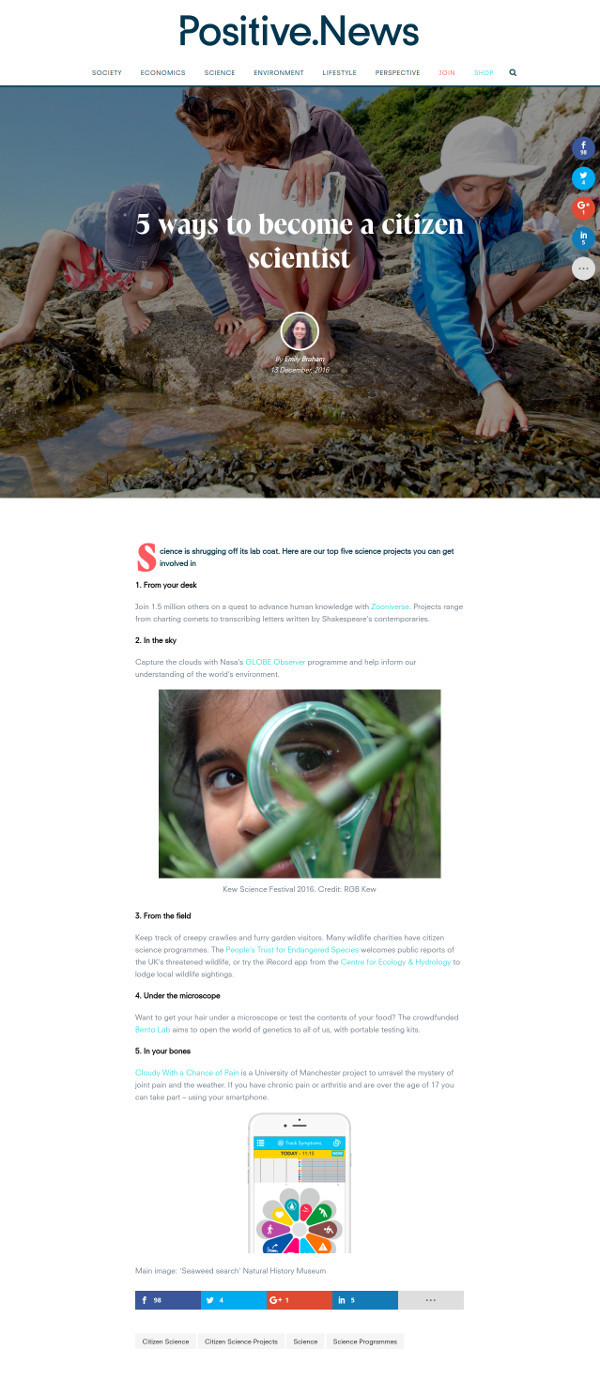
Like the magazine, the website design puts photographs and illustrations front and center — perhaps a bit at the detriment of readability for shorter articles
Design and Content
The website publishes feature-length articles and short newswire pieces, categorized into sections such as “lifestyle” or “economics”. Just like the printed magazine, the site is very visual, placing significant emphasis on design, typography and large lead images.
The site uses Disqus for comments. Activity is low (most conversations happen on the site’s Facebook feed) but there is little trolling or negativity in the comment section.
Although the organization is based in the UK, much of its reporting is international in nature (some is syndicated from other sources, including NGOs). The articles tackle tough subjects: climate change, terrorism, racism, and so on. But they focus on people working on solutions (“on patrol with an all-women anti-poaching unit”; “5 grassroots responses to terror attacks”) rather than on simply pointing out the gravity of problems.
For the most part, this isn’t about replacing bad news with good news — it’s about restoring a sense of agency. I found the reporting reasonably dispassionate, but it typically only scratches the surface and is not evaluative in nature (“does this work?”).
Site content is under conventional copyright.
The Verdict
I recommend adding Positive News to your media diet: 4 out of 5 stars. I am swayed by the argument that constructive journalism is psychologically valuable, and it undeniably brings attention to important causes. It also may inspire readers to replicate good ideas.
The organization behind the site would benefit from greater transparency about its revenue model and its plans for the future, especially if it intends to further pursue sponsorships and advertorials which may compromise real or perceived impartiality.
The site’s large social media reach demonstrates that there is a growing hunger for this type of journalism. Other media ventures would do well to consider how they can provide similar value to their audiences, e.g., by doing more feature reporting on solutions as opposed to problems.
These facts are not in dispute: the gun homicide rate of the United States is 25 times higher than that of other high-income countries. Last year, more than 15,000 people died from gun injuries, excluding suicides. Chicago’s number of gun victims since 2001 has exceeded US troop deaths in war zones in Iraq and Afghanistan.
It’s a system of violence sustained by a large industry. Guns and ammunition stores had revenue of about $9B in the last year, and the National Rifle Association, a nonprofit with 5M members that opposes gun control, had $348M in revenue in 2013.
Everytown and The Trace
National groups promoting gun control have long paled in comparison with the NRA. Former New York mayor and 10th richest person on Earth, Michael Bloomberg, is working to change that. To this end, he funded the advocacy group Everytown. Its action fund reported $39.5M in revenue in 2015; much of it comes directly from Bloomberg.
Beyond its lobbying and activism, Everytown has seeded a new nonprofit newsroom, The Trace, to engage in specialized reporting on gun violence.
I was not able to find a tax return for The Trace (the organization did not respond to email inquiries), suggesting it probably hasn’t filed one yet. The “About us” page credits the Kendeda Fund and the Joyce Foundation as funders in addition to Everytown; Huffington Post co-founder Ken Lerer and liberal venture capitalist Nick Hanauer are listed as individual supporters.
The Trace does not define itself as partisan or nonpartisan; it states that it simply seeks to carry out public interest journalism to shed light on the problem of gun violence. It has partnered with many other publications to achieve this goal, including The Atlantic, TIME, and the Guardian.
Content Example: Murder Inequality
The article about “murder inequality” is a good example of evidence-based journalism. Its premise is that looking at city-level crime statistics is misleading because the disparities between neighborhoods (both in crime and poverty) can be dramatic.
This is consistent with increasing evidence that the economic barriers in American society are almost impenetrable. If this article has an agenda beyond broadening the evidence base of public discourse, it’s impossible to discern what it might be — it simply cites the available data in an easy to understand form (kudos for the use of interactive embedded charts with source code).
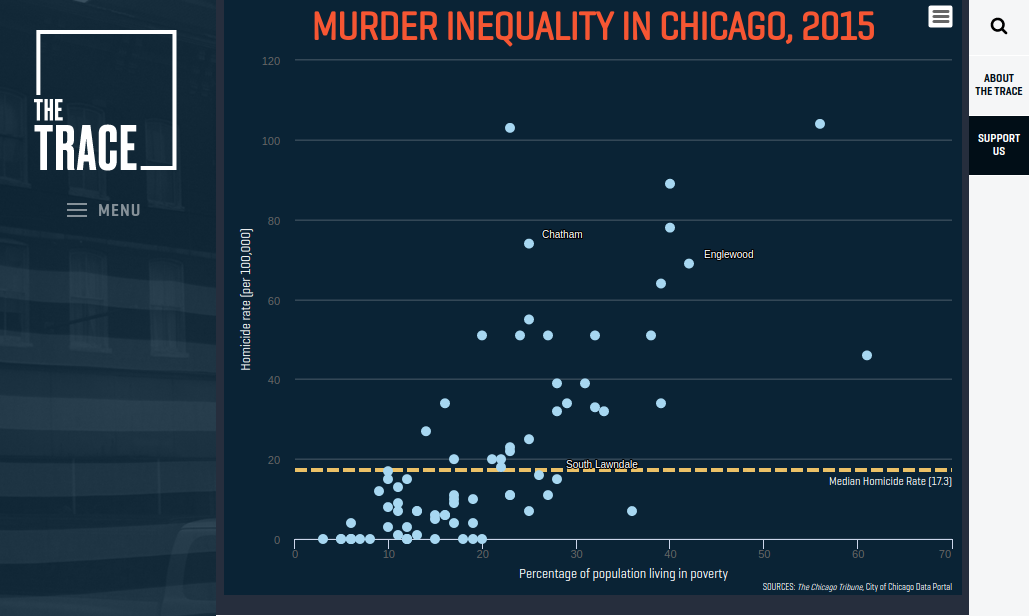
The article on “murder inequality” includes an elegant, interactive visualization that makes the large disparities between Chicago neighborhoods apparent.
Content Example: Killing of an 89 Pound Boy
“The Reasonable Killing of an 89-Pound Boy” is an in-depth look at the case of Martinez Smith-Payne, a 13-year-old kid from St. Louis, MO shot dead for rummaging through someone’s car looking for change. The article places the killing in the context of Missouri’s “Stand Your Ground” laws. These laws offer legal protection for the use of deadly force in defending one’s life or property, with hotly debated consequences on crime rates.
The article is a solid piece of journalism which largely refrains from value judgments (other than the implicit value judgment that “killing children for stealing change is bad”). Together with more data-centered articles, it contributes usefully to the discussion about “Stand your Ground” laws by way of a particularly horrifying case study.
Content Example: NRA and Immigration
This article from the category “Gun Lobby” tackles Donald J. Trump’s anti-immigration rhetoric and actions, and the NRA’s record of siding with far right anti-immigrant positions.
Though not labeled commentary, the article is much more explicit in its value judgments. It explicitly accuses NRA executive Wayne LaPierre of “inflaming fears” and uses phrases such as “So much to be afraid out of there. If only there were a wall!”
While I strongly agree with its sentiments, it would be fair to describe it as advocacy journalism grounded in liberal values.
Design, Licensing
The Trace is powered by WordPress. It uses a slick theme that’s easy on the eyes and straightforward to navigate. The design shop behind the site, Upstatement, published a “making of” that gives some insights into the process.
As one would expect from a WordPress site, it works well on mobile devices and without JavaScript. Content is categorized into areas such as “Gun Policy”, “Data”, “Politics”; commentary is in its own category.
There is no “Terms of Use” page, so by default, content is under conventional copyright.
Note that the main site’s RSS/Atom feed is not advertised and can be found here: https://www.thetrace.org/feed/
The Verdict
The journalists at The Trace do an admirable job providing news and data to anyone concerned about the problem of gun violence, whether because they’re personally affected, or otherwise moved to care and do something about it. I recommend following the site if you fall into either category, and it is part of our Twitter list of quality nonprofit media.
Responsible gun owners who support more consistent gun control and safety measures should find the site generally to be fair in its coverage, but may take umbrage at the occasional slip into value judgments they disagree with.
There are two minor criticisms. First, The Trace would benefit from the standard bits of nonprofit transparency: continuous reporting about organizational impact, more financial details, and so on.
Second, the site seems to not be quite clear yet who its target audience is — some articles lack a clear “through line”, others stray a bit into commentary or advocacy without being labeled as such. Explicitly adopting a journalistic code of ethics (example: ProPublica) could help to establish a more consistent standard for readers and writers alike.
The intelligence and passion of the site’s editorial team are evident, and there’s every reason to believe it will play an increasingly important role informing the debate about guns and violence. 4 out of 5 stars.
You may never have heard of the Wellcome Trust, but with a £20.9B ($26.7B) endowment, it is one of the largest philanthropies and the largest non-government funder of health research in the world. Established in 1936 after the death of American British pharma magnate Henry Wellcome, it has retooled itself into a modern science funder and promoter of open access to scientific research.
Beyond direct funding for research, Wellcome also supports science communication projects, and Mosaic is an in-house effort launched in 2014 to publish “compelling stories that explore the science of life.”
The model is simple: every week, Mosaic publishes a long-form story or other journalistic work. Some examples:
-
a look at kangaroo care, a child care concept for pre-term babies pioneered in Colombia,
-
an investigation of the work of Robert G. Heath and his almost forgotten research. Heath implanted electrodes in human brains and gave them the ability to self-stimulate their pleasure center. He also attempted to “cure” homosexuals.
-
an overview of the current state of thinking about animal intelligence.
These articles are written for a general audience. They would be right at home in, say, the New Yorker, but might be a bit too light on details for Scientific American. Illustrations are often artistic rather than technical. There is some podcast and video content as well.
Occasionally, Mosaic experiments with data journalism. A good example is the Global Health Check, which is a nice way to explore how health indicators have changed since the year of one’s birth.
Other Aspects
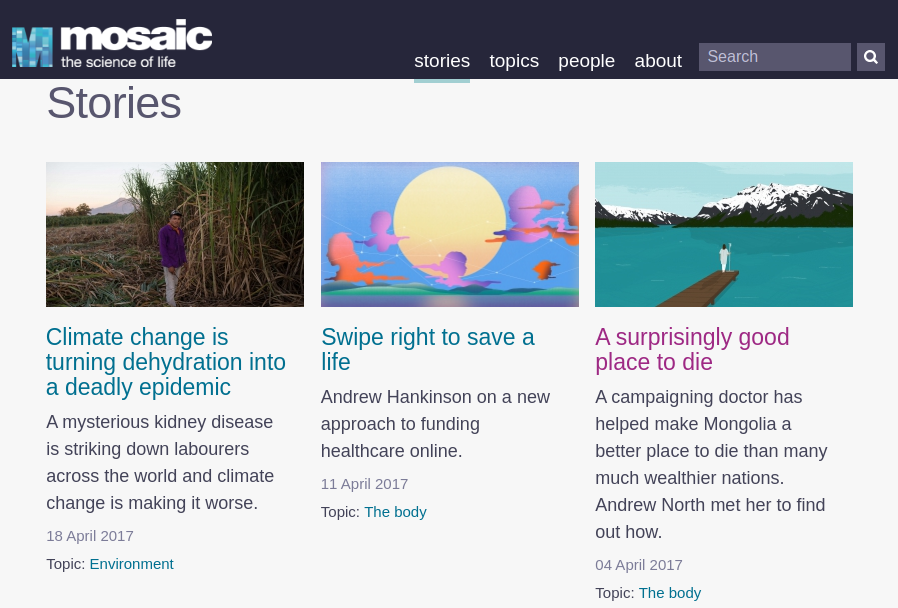
The site design is entirely inoffensive, and some of the illustrations are quite beautiful.
Given the financial position of its parent organization, you won’t find any ads or donate buttons on the site. You also won’t find a lot of information about Mosaic’s organizational internals (though there are mountains of documents about Wellcome itself).
The site design is unremarkable and easy to navigate. It works well on mobile devices and without JavaScript.
Mosaic is described as editorially independent, and its reporting goes beyond projects Wellcome funds. I did find disclosure statements where appropriate. It’s also nice to see that every person involved with a story is credited at the bottom of each story (author, editor, copyeditor, fact checker, art director, illustrator, etc.), a practice I’d encourage other media to emulate.
Consistent with Wellcome’s open access policy, Mosaic content is under the Creative Commons Attribution License, allowing anyone to re-use it for any purpose provided credit is given.
The Verdict
If you’re at all interested in life science, I can’t think of any reason not to follow Mosaic’s work. It’s fairly easy to decide whether the weekly story is something you care about, and if it is, the journalism is generally of very high quality and a pleasure to read.
The focus of Mosaic is on the process of scientific exploration, on the scientists and caregivers, and on the lives impacted by their work. There’s room for improvement in how more technical aspects and key takeaways are conveyed. Call-outs or sidebars summarizing key concepts of an article might help readers who are short on time, or who just want a bit more than a teaser before deciding to spend 30-60 minutes on a story.
You can follow Mosaic on social media (Twitter, Facebook) to get updates and reposts, or you can subscribe via email to get only the new stuff. They’re also part of our Twitter list of quality nonprofit media. The rating is 4 out of 5 stars: recommended.
If you’ve been online since the late 90s, you probably have known about CounterPunch for a while. After 9/11, it became one of the primary sources for non-mainstream information about US foreign policy, while usually staying clear of the most absurd conspiracy theories.
The project was started as a print newsletter by Ken Silverstein in December 1993 (1993-2011 archives). A one-year subscription to 6 issues of the 36-page newsletter currently clocks in at $50 for US residents. Website content is unrestricted and ad-free.
I would situate the politics of CounterPunch on the antiwar far left (think Ralph Nader/Jill Stein), with some curious contradictions. For example, co-founding editor Alexander Cockburn (deceased in 2012) did not believe in climate change and opposed gun control.
The nonprofit organization behind the site (incorporated as the “Institute for the Advancement of Journalistic Clarity” in California) is as small as you might expect; it reported revenue of $427K in 2015, and did not report any employee compensation, suggesting a shoestring operation.
Unsurprisingly for a tiny org, there’s not much in the way of organizational transparency on the CounterPunch website: no reports, no financial statements, no link to the tax returns.
Content
CounterPunch primarily publishes analysis and opinion rather than original news reporting. Its writers include journalists and authors, activists and academics. It publishes a lot of material – the current “weekend edition” contains 45 articles, some exclusively published on CounterPunch, others cross-posted elsewhere.
The site doesn’t make much of an effort to organize this flood of information. The latest headlines are listed in the sidebar, and excerpts from selected articles in the middle column. The reader has to navigate opaque headlines like “We Aren’t Even Trying”, often without any additional context other than the author’s name.
Editing is hit-or-miss, and citations are few and far between. The website is more of a group blog than a journalistic enterprise, and to get value out of it, readers need to become familiar with the authors whose judgment they trust.
The site covers international politics with special focus on US domestic and foreign policy. There’s no meaningful distinction between types of content (e.g., news vs. opinion), and it’s not unusual for posts to adopt disparaging monikers like “Killary” (for Hillary Clinton), or to ascribe malevolence to political actors. Example:
“And certainly Sanders’s Iraq vote suggests he is not as reckless or bloodthirsty as Killary, but that is setting the bar somewhere beneath the belly of a viper.”
The tone is set at the top – editor Jeffrey St. Clair, too, uses monikers like “MSDNC” (for MSNBC) or “Hillaroids” (for Hillary Clinton supporters).
Positioning, Bias
The underlying perspective shared by many CounterPunch writers is that the leading political forces in the US are equally bad. Individuals like Julian Assange who express viewpoints opposing the US are uncritically celebrated. Here are a few headlines about Assange (who has also published on the site):
- “Julian Assange is a Political Prisoner Who Has Exposed Government Crimes and Atrocities” by Mark Weisbrot (2017)
- “New York Times Shames Itself By Attacking Wikileaks’ Assange” by Dave Lindorff (2016)
- “Julian Assange: the Untold Story of an Epic Struggle for Justice” by John Pilger (2015)
- “Why Julian Assange is My Hero” by Jennifer van Bergen (2010)
- “Julian Assange: Wanted by the Empire, Dead or Alive” by Alexander Cockburn (2010)
This hyperpartisan cheerleadership facilitates the spread of misinformation. For example, CounterPunch also published “Droning Assange: the Clinton Formula”, which was based on a story by True Pundit, a fake news site in the narrowest sense of the term (the made-up claim was uncritically repeated by site editor Jeffrey St. Clair).
It also ignores the many criticisms that have been raised about Wikileaks, which turned itself into a propaganda machine for the alt-right in the 2016 election cycle, up to and including proliferation of complete nonsense such as the infamous “Spirit Cooking” tweet.
Generally, CounterPunch publishes material consistent with a specific narrative: the US is the world’s dominant superpower, and therefore global issues can usually be traced to American action and inaction; in contrast, claims about misbehavior by countries not aligned with the US should be regarded with extreme skepticism. This view can perhaps be best summed up with this image shared via the site’s Twitter account:

How CounterPunch views the world. Source
Consistent with that idea, CounterPunch is receptive to apologia for dictators the US doesn’t like – it has published numerous stories defending Venezuela’s increasingly brutal and corrupt regime, for example. In extreme cases like the Syria conflict, it has published bizarre pro-Russian propaganda pieces such as William Blum’s oeuvre. In one recent article titled “The United States and the Russian Devil: 1917-2017”, Blum writes:
The same Western media has routinely charged Putin with murdering journalists but doesn’t remind its audience of the American record in this regard. The American military, in the course of its wars in recent decades, has been responsible for the deliberate deaths of many journalists. In Iraq, for example, there’s the Wikileaks 2007 video, exposed by Chelsea Manning, of the cold-blooded murder of two Reuters journalists; the 2003 US air-to-surface missile attack on the offices of Al Jazeera in Baghdad that left three journalists dead and four wounded; and the American firing on Baghdad’s Hotel Palestine, a known journalist residence, the same year that killed two foreign news cameramen.
There is in fact no evidence that journalists were specifically targeted (“deliberate deaths”) in the incident exposed by Wikileaks or the firing on the hotel. A much stronger case can be made that the attack on Al Jazeera was deliberate, and indeed US right-wing media agitated in favor of such attacks at the time, labeling Al Jazeera “enemy media”. If intentional, this certainly was an immoral and illegal attack.
A fair comparison would look at Russia’s own record in wartime and in peacetime, including the staggering list of journalists murdered within Russia. But a fair comparison is clearly not what Blum is aiming for.
In an aside, Blum credits Donald Trump for “not [being] politically correct when it came to fighting the Islamic State.” This is the same Trump who campaigned on the promise of murdering terrorists’ families. As for Russia’s own imperialist ambitions? Here’s Blum’s pro-Putin take:
Lastly, after the United States overthrew the Ukrainian government in 2014, Putin was obliged to intervene on behalf of threatened ethnic Russians in Crimea and eastern Ukraine. That, in turn, was transformed by the Western media into a “Russian invasion”.
In this view of the world, actions by actors the US dislikes are almost always defensible when viewed in light of alleged American behavior. That is not to say that the antiwar perspective isn’t useful – of course it is. But many of the writers CounterPunch publishes tend towards dogma, disinformation and rhetoric more than rigorous analysis, which makes the site, at best, a mixed bag.
At its worst, it enables demagogues. For example, CounterPunch routinely publishes Israel Shamir’s writings (including an execrable defense of Pol Pot). On his own website, Shamir has published an essay about Holocaust denier David Irving (emphasis original):
Technically, David Irving was sentenced for so-called “holocaust denial”. But the concept of Jewish holocaust being the only enforced dogma of supposedly secular Europe has little to do with the Second World War and its atrocities.
(…)
They say that even their death is not like the death of anybody else. We must deny the concept of Holocaust without doubt and hesitation, even if every story of Holocaust down to the most fantastic invention of Wiesel were absolutely true.
(…)
European history went full circle: from rejecting the rule of Church and embracing free thought, to the new Jewish mind-control on a world scale.
There’s not much to say here – no defense of this anti-Semitic rubbish is possible. Yet, CounterPunch has published more than 50 posts by the person who wrote these words.
Other Aspects
As noted, the website design overall is minimal and doesn’t aid discovery. Articles are usually just text; image embeds are often low-resolution, and other types of embeds (charts, interactive maps, etc.) are nowhere to be found.
The site works reasonably well on mobile devices. It refers to its Facebook presence for discussions, which is not a bad move – however imperfect, Facebook’s ranking algorithms at least mean that some of the better comments will come out.
CounterPunch content is under conventional copyright.
The Verdict
If you are looking for sources that help you understand what is going on in the world, I cannot recommend CounterPunch. Reading it may be cathartic if you share the specific views evinced by many of its writers, but the occasional bit of well-researched reporting is drowned out by one-sided commentary and analysis.
The site’s willingness to offer a platform to writers like Shamir suggests either very sloppy oversight or, worse, sympathies for anti-Semitic views. Either way, it makes the site less useful as a source to be cited and shared.
Evidence like the proliferation of the “Drone this Guy” story shows that even obviously made-up nonsense will not be weeded out reliably. Caveat lector applies – if you do rely on CounterPunch material, track down sources and verify that they really say what the author claims.
This is obviously not a criticism of every writer who publishes on CounterPunch. The site has been around for a long time and has attracted many widely respected left-wing and antiwar intellectuals. Project Censored, which does good work highlighting stories underreported in major media, has recommended a few CounterPunch pieces over the years.
However, since the 90s, many much more interesting alternatives have emerged, for example:
- Common Dreams and Truth Out publish many writers from the antiwar left, but are more carefully edited and curated;
- The Intercept and New Internationalist provide in-depth original reporting on international war and social justice issues;
- Jacobin publishes explicitly socialist perspectives on current and historical events, while being usually reliably in opposition to all forms of authoritarianism.
2 out of 5 stars, with points off for poor editing, sensationalism, misinformation, and distortion through extreme one-sidedness.
Of all the publications we’ve reviewed so far, Science News has by far the largest social media reach. With 2.27M followers on Twitter and 2.7M “likes” on Facebook, it easily outperforms many for-profit science outlets like LiveScience or SPACE.com, and is on par with Scientific American.
Granted, it’s had a bit of a head start. Science News has been in print since 1922 by the Society for Science and the Public. As the name suggests, Science News focused on giving updates on the latest scientific discoveries, but that includes some in-depth feature stories, as well. A print edition is issued every two weeks.
The online version includes a steady stream of mostly brief science updates alongside a set of staff blogs which effectively function as an analysis/opinion section.
Blog posts are available indefinitely, while articles become paywalled after a year (as of this writing, a digital-only Society membership that grants full archival access costs $25/year). You can also preview the print magazine before joining, a nice touch that I’d like to see other print publications adopt.
The organization also publishes Science News for Students, which targets “teens and tweens” and includes helpful glossaries in each article. Unlike the main site, its articles never get paywalled.
Funding, Compensation, Transparency
Per the latest available tax return, Science News had $18.6M in revenue in 2015. $6.5M of its expenses were allocated to Science News itself. In addition, the Society runs some of the largest science outreach projects in the country, each sponsored by a different corporation: the Intel Science and Engineering Fair, the Regeneron Science Talent Search and the Broadcom MASTERS science competition. Together, it spent $12.8M on these and other outreach programs.
CEO and President Maya Ajmera received $323K in total compensation including benefits in 2015. While a bit high by nonprofit standards, it’s well below the outliers we’ve reviewed (which are also smaller organizations). Ajmera brings impressive nonprofit credentials to the job: as a 25-year-old, she founded the Global Fund for Children, which has since grown into a large international grant-making organization. Editor-in-chief Eva Emerson received $200K in total compensation.
Unusually, the program areas such as the competitions generated 74% of the organization’s revenue in 2015 per the Annual Report, and the magazine only generated 23%. The report notes: “Print circulation declined 4.5 percent, to end the year with 84,548 paid subscribers. Despite the growth in digital readers, the magazine operates at a loss.”
Positioning, Coverage
The Society describes itself as being “focused on promoting the understanding and appreciation of science and the vital role it plays in human advancement: to inform, educate, and inspire.” Science in this context means primarily STEM – (natural) science, technology, engineering, and mathematics.
Its articles are typically written in a lighthearted tone, e.g.: “Dengue fever spreads in a neighborly way. Dengue is a bit of a homebody.” Some scientists may occasionally bristle at the publication’s liberal use of similes, but I did not encounter clickbait or sensationalism, nor did I find evidence of major inaccuracies.
The articles are typically short and illustrated, making the key conclusions easy to grasp. Cited papers are referenced directly, which isn’t necessarily a given in science reporting – other publications often reference an institution’s own press release, making it necessary to dig for the actual paper.
Science News generally stays away from political controversy and “science vs. pseudoscience” arguments. For example, a Google search for homeopathy yields no relevant article results (an internal search turns up the paywalled article “Dilutions or Delusion?” from all the way back in 1988). Homeopathy is obvious pseudoscience, so its exclusion is reasonable – but if you’re looking for arguments why something is or isn’t considered science, you might not find them here.
The publication did weigh in on the 2016 election with its own report: “See where Clinton and Trump stand on science”. It’s a neutral summary based on public statements and the responses to 20 questions posed by ScienceDebate.org, an independent effort the Society supports. In contrast to Scientific American (candidate assessments), Science News made no attempt to grade the candidates’ answers. Some might find its approach here a bit anemic and suffering from false balance, especially when considering the planetary stakes on issues like climate change.
Design, Licensing

Then and now: Science News in 1939 vs. today
The site’s design is straightforward, with a left-hand column showing the latest headlines, and a right-hand area featuring story summaries. There’s little clutter to distract from the content, and you can safely turn off your ad-blocker if you don’t mind an occasional splash screen. There are small “sponsor messages”, but they are largely self-referential, e.g., an ad for the Science News app.
The color scheme is a bit too low-contrast; some of the grey-on-grey text is difficult to read even without vision problems. The site works fine without JavaScript and on mobile devices.
Each story features a Disqus-powered comments section, and the Science News staff does moderate comments that violate its policies. In spite of that, the signal-to-noise ratio of comments isn’t very high, but you’ll occasionally find very knowledgeable commenters.
Predictably, content is under conventional copyright, though Science News makes heavy use of photos and illustrations from free/open repositories such as Wikimedia Commons.
The Verdict
Science News is a fine source of daily updates on STEM topics, and the Society’s many outreach efforts are laudable and important. Its coverage avoids controversy, meaning that you may need to look elsewhere for background science on highly politicized topics like abortion, or for debunking pseudoscience.
Like many traditional publications with origins in print and declining print subscriber numbers, it’s clearly still trying to figure out its place in the new media landscape, but the large amount of quality content it produces combined with its reputation and strong branding have already given it a highly impactful online presence.
Organizationally, the Society shows all the signs of a well-run traditional nonprofit, and its Annual Reports give a good overview of its activities.
With all that said, it’s a bit sad to see so much quality content disappear into restricted archives (and it makes linking a bit pointless in the long run, unless you want to go digging on archive.org). It would be good to see the organization experiment with models that enable it to keep more of its articles freely available. For content that’s permanently unrestricted (such as the Science News for Students website), releasing it under a free license seems to have no obvious downside.
The final rating is 4 out of 5 stars – Science News offers good summaries, but for depth and breadth, you may want to complement it with other science-focused sources.
While the scientific consensus is clear that human civilization is rapidly changing the climate through uncontrolled greenhouse gas emissions, details matter. Which regions will be hit hardest? Which natural disasters can be attributed to climate change? Do positive effects outweigh negative ones in some regions?
To tell this story accurately requires grappling with the latest scientific findings. Science/environment beat writers must do their best to translate these findings to their audiences. Sometimes the truth gets lost in translation, and important findings may be missed. Moreover, traditional media prefer reporting on the human drama of the moment (crime, politics, etc.), and climate change rarely gets the attention it merits.
Is there a better way? Climate Central combines climate science and climate journalism in a single nonprofit organization. It is less focused on the politics of climate change than, say, InsideClimate News (review), but it does cover policy interventions, as well.
It’s been fully operational since 2009 and is based in Princeton, New Jersey, near the famous university. That’s no coincidence. One of the organization’s biggest seed funders is Princeton alum Eric Schmidt (of Google/Alphabet fame), and several staff and Board members are Princeton-affiliated.
Funding and Compensation
The organization’s latest tax return shows revenue of $9.3M, which places it among the better-funded nonprofit journalism outfits.
Most of this funding comes from foundations, but the organization also lists government agencies such as NASA and the US Department of Energy among its supporters. Funding is not further broken down (by year/gift size), and multiple requests for details through the site’s contact form received no reply.
The organization does not publish Annual Reports, and there is no other page that speaks to impact of specific programs, with one exception: The “What We Do” page features a loose list of links to articles by many international publications which have featured Climate Central’s news and research.
Program expenses are split between journalism ($2.7M) and research ($2.2M). Executive compensation is very high by nonprofit journalism standards: CEO Paul Hanle received total compensation (including benefits) of $379K in 2014, Chief Scientist Dr. Heidi Cullen received $395K, and two (S)VPs received more than $280K in total comp.
Granting that Climate Central is an unsual organization, the Union of Concerned Scientists (based in Cambridge, MA – not much less expensive than Princeton) may serve as a useful additional benchmark. It is a much bigger organization, with $26.6M revenue in 2013-14 (tax return), yet its Executive Director received “only” $270K in total comp, and its Chief Climate Scientist (who was one of the Lead Writers of an IPCC report) received $186K.
Sampling the News Feed
-
“Trump and Automakers Target EPA Mileage Rules” is a typical Climate Central news story. It neutrally summarizes how the Trump administration is following through on a campaign commitment to roll back EPA rules implemented towards the end of Obama’s second term, and quotes both environmental experts, an auto industry lobby group, and an environmental advocacy group. (There’s nothing wrong with quoting industry lobby groups, as long as their interests are clearly identified. Problems arise when dealing with “think tanks” that act as corporate front groups, pretending nonpartisanship.)
-
“Polluters Could ‘More Easily’ Commit Crimes Under Cuts” examines the Trump administration’s proposed EPA budget. Importantly, it highlights some landmark EPA settlements and the complexity of cross-state pollution by large corporations, which refutes the idea that a state-level regulatory approach is sufficient. Again, the article is neutrally written and cites multiple voices, largely focusing on expert opinion.
-
“Carbon Dioxide Is Rising at Record Rates” cites recent measurements of the carbon dioxide concentration and is partially based on a press release by the National Oceanic and Atmospheric Administration. Climate Central includes its own simplified version of the NOAA chart (see below) and adds useful additional data and context.
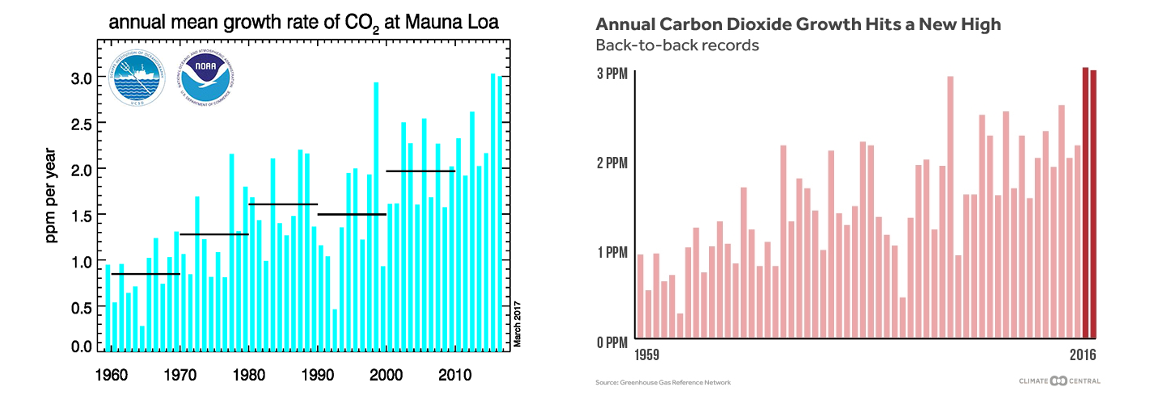
The NOAA version of the chart vs. the Climate Central version. To simplify it, Climate Central removed tick marks, labels for in-between years, and 10-year average bars, and highlighted the most recent years. The most idiosyncratic of these changes is the removal of the year labels; most publications show at least some in-between year markers for time series data (NYT example, Vox example, Bloomberg example).
Other Projects
Beyond its news feed, Climate Central makes efforts to translate its own research into explanatory journalism. Sea Level Rise is one such example project. It is based on peer reviewed research such as the paper “Carbon choices determine US cities committed to futures below sea level”, and translates these findings into interactive visualizations.
An example of these visualizations is the “Seeing Choices” map which displays the sea level rise in cities like New York under different temperature scenarios.
Some news feed stories also feature interactive content, such as “Meltdown: More Rain, Less Snow as the World Warms”. Many of these interactive widgets are embeddable, though they don’t offer the rich set of share/embed/download options a site like Our World in Data does.
I didn’t find a list of all papers published by Climate Central scientists, or an open access policy, though the papers that are referenced do appear to be freely available online.
Design and Licensing
The main website doesn’t have a mobile version (a pretty major fail in 2017), and it is a bit cluttered with many sections competing for attention (“featured content”, “climate services”, “special sections”, etc.), drowning out the news portion of the site. Perhaps to make up for that, a large story carousel features the latest headlines.
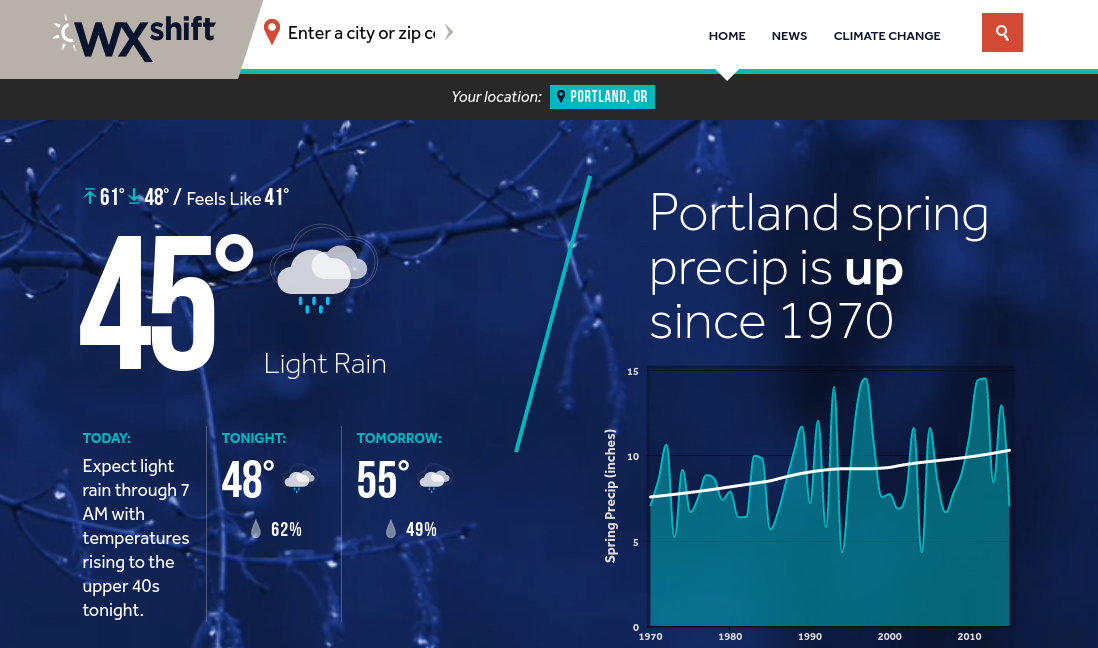
wxshift provides local weather information in combination with longer term climate data and other climate change context. While much more visually appealing than Climate Central, it does not appear to have much of an audience yet.
Climate Central has created much slicker story-centric designs for some of its feature reporting (example). It also operates wxshift, which combines weather reporting with context about how climate change is impacting the weather. Some of the main site’s news content is mirrored to wxshift, as well. Launched in 2015, it appears to have only a very small audience (as of this writing, it has 1,751 Twitter followers and barely registers on traffic ranking tools like Alexa).
Climate Central’s content licensing page is restrictive, requiring case-by-case permission requests rather than using a free license for some or all content. This is fairly typical; even among nonprofits, permissive licensing terms are the exception, not the norm. The organization goes through a lot of trouble to create graphics and maps, which would be entirely appropriate in reference works like Wikipedia, where they could be added to articles read by millions – but the restrictive copyright terms make that kind of re-use impossible.
The Verdict
Climate Central’s journalism+science approach usefully complements more politically focused sites like InsideClimate News. Its journalism is nonpartisan, understandable, and fair, while being based on the scientific consensus. If you care about climate change (and unless you are reading this from another planet than Earth, you should), it’s a source worth adding to your social media or RSS reader.
The main site could use an upgrade. While it’s certainly non-trivial to upgrade older sites, there are many open source projects specifically targeting nonprofit journalism, such as the Institute for Nonprofit News’ widely used Largo Wordpress theme and the Ghost publishing platform.
The organization would also benefit from greater transparency. Being open and accountable about how impact is measured and under what conditions projects are shut down can help donors appreciate that their support is put to good use, and that projects aren’t just left to spin even if they aren’t producing a lot of bang for the buck.
The rating is 4 out of 5 stars, with high marks for the overall quality of Climate Central’s journalism. 1 point off for lack of organizational transparency, for executive compensation well above other science and journalism nonprofits, and for a site design that is not consistently mobile-friendly.
The scientific consensus is clear, the predictions range from bad to worse: we are slowly heating the Earth by pumping greenhouse gases into its atmosphere, with increasingly disastrous consequences. Yet politicians whose careers depend on fossil fuel industry support are as eager as ever to peddle doubt and uncertainty to justify inaction.
In US politics, the governing political party is now fully identified with climate denial. In the media, organized denial continues to this day in publications ranging from center-right (Wall Street Journal) to “alt-right” (Breitbart). See the chapter on organized climate change denial in the Oxford Handbook of Climate Change and Society for a scholarly overview of the machinery of denial.
How should journalists tackle the issue? Not, many scientists warn, by engaging in false balance, but by giving consistent and serious attention to the matter. So far, such warnings have fallen on deaf ears in the US. Never mind balance: not a single question in the US presidential debates focused on climate change, and the ultimately successful candidate has repeatedly called it a hoax.
InsideClimate News (ICN) is one nonprofit news site that wants to close the gap between environmentalist advocacy and the limited reporting on climate change by major media. Explicitly nonpartisan, it has won multiple awards for its journalistic work, including a Pulitzer prize for “The Dilbit Disaster: Inside The Biggest Oil Spill You’ve Never Heard Of”. That article series was the result of a seven month investigation into a pipeline spill of diluted bitumen (dilbit), and the expensive and unprecendented cleanup that followed.
The site was founded by David Sassoon, a former PR industry professional, in 2007. The American Press Institute interviewed him on the occasion of the Pulitzer award, and he provided some background on his motivation to start the site:
Back in 2007 it looked like the country was getting ready to move toward national climate legislation. And we were very much attuned to the interest in the business community and the economic case for taking action. We also saw that the mainstream reporting on climate change was flawed. It was still reporting as if there was equal doubt about man-made global warming — when really on one side you had politics and the other side science, which was indisputable.
The site transitioned from a small blog into a full journalism operation that built partnerships with Reuters, Bloomberg, The Weather Channel, VICE Media, and others. It was initially part of the nonprofit incubator NEO (formerly known as “Public Interest Projects”) and now operates as an independent organization.
Funding, Transparency, Executive Compensation
InsideClimate News has published a single Annual Report so far, for 2014. According to it, the organization spent $961K in 2014. 88% of revenue is attributed to foundations and 8% to individual/online donors. One nice touch: individual donors starting at the $10 level are listed by name. The website also lists foundation supporters, which include some common names like Ford, Rockefeller, and Knight, but also environmental funders such as the Leonardo DiCaprio Foundation and the Wallace Global Fund. Corporate sponsors like The North Face get logo placements on ICN’s website.
The Annual Report focuses more on what ICN does (showcasing especially its many media partnerships) than what impact its stories have accomplished in the real world. However, through 2016, ICN has published two newsletters, which do speak to impact. For example, from its April 2016 newsletter:
Although our Exxon: The Road Not Taken series launched last September, its momentum continues. Not only have the original set of stories won a series of journalism awards, they helped kick-start a push to investigate whether Exxon misled the public and investors on climate, with several states and the U.S. Virgin Islands now joining New York Attorney General Eric Schneiderman in the effort.
In an email, David Sassoon told me that the organization is shifting to releasing a full report in even years, supplemented by quarterly reports in odd years. He also suggested that previously distributed quarterly reports would be added to the public archive soon.
In ICN’s 2014 tax return (which shows $1.5M in revenue), Sassoon’s compensation is listed at $98,400 total, and writers are listed at $51K-$76K/year. Assuming this covers a full year of compensation, this is at the bottom end of organizations we’ve reviewed, though ICN is also one of the smallest organizations we’ve looked at in terms of revenue.
Right-Wing and Fossil Fuel Industry Attacks
It’s worth noting that ICN has come under attack from right-wing groups. In 2015, Jillian Kay Melchior wrote the article “InsideClimate News: Journalism or Green PR?” for National Review, a conservative paper which endorsed Ted Cruz (“Climate change is not science, it’s religion”) for President in 2016.
The critique doesn’t withstand cursory scrutiny and rests on ICN’s long existence as a small-scale effort bootstrapped with help from a nonprofit incubator and Sassoon himself. But it is bolstered by groups like the Media Research Center, which receives most of its funding from Breitbart/Trump-aligned billionaire Robert Mercer and has also cashed in hundreds of thousands of dollars from – wait for it – ExxonMobil.
To be sure, the fossil fuel industry really, really doesn’t like InsideClimate News. In addition to the aforementioned proxies, it regularly feuds with the small nonprofit through its own PR arms such as ExxonMobil Perspectives (examples) and Koch Facts (examples).
The goal here is probably not to convince environmentalists or even right-wing activists, as these websites receive tiny amounts of traffic, but to disrupt partnerships and funding, and to firmly push ICN into the categorization of “advocacy journalism” in order to undermine its journalistic credibility.
Positioning, Bias
As noted, ICN considers itself nonpartisan, but starts with the assumptions that there is no ongoing international conspiracy to perpetuate the climate change hoax and conceal its origins, and that the scientific community generally has an idea what it’s talking about. If you think those are reasonable assumptions (and – surprise, surprise – I do), that still leaves some important questions:
- Does ICN report on legitimate scientific disagreements?
- Does ICN report on legitimate policy disagreements?
- Does ICN treat the subjects it reports on (e.g., scientists, corporations) fairly?
Generally, ICN articles are written in a neutral tone. There are no parts of the site that are dedicated to activism. Compared to, say, Rewire (which we described to advocacy journalism in our review), this is a much more straightforward news site.
ICN staff sometimes write backgrounders such as “Republican Carbon Tax Proposal: Novel Climate Solution or Regulatory Giveaway?”. These are also not advocacy pieces – the article in question is a good example of balancing different perspectives, though it would benefit from citing sources.
Stories like “Warming Climate May Limit Lyme Disease’s Spread in Parts of the U.S.” clearly don’t serve an activist narrative. ICN also looks critically at the way scientific findings are used (“Both Sides in Climate War Blamed for Cherry-Picking Attribution Research”) and reports on ambivalent findings (“Study Delivers Good News, Bad News on Methane Leaks from Fracking Operations”). It includes fossil fuel industry voices/statements in some of its stories, as in this recent report on the Dakota Access Pipeline, even though industry spokespersons sometimes refuse to engage with ICN.
When it comes to renewables, the story “EPA Loopholes Allow Biomass to Emit More Toxic Air Pollutants Than Coal, Study Says” is an example of a critical look at a “renewable” technology (biomass) that is increasingly viewed critically, as recent reports on wood pellet energy schemes indicate. ICN also reports on carbon capture and storage and other technologies that could work in conjunction with fossil fuel use. At the same time, I found few stories on nuclear power, or on the ecological effects of large wind/solar projects. Similarly, I learned about the promising Allam cycle technology from Forbes – ICN has never mentioned it.
ICN does give most visibility to scientist and activist voices, and when it comes to climate change, tends to focus on stories that highlight risks of inaction, or show the potential of clean energy sources. Its in-depth coverage of the Environmental Protection Agency’s fracking study is a good example of its critical vantage point. Indeed, ICN sometimes describes itself as a source of “hard-hitting watchdog reporting”.
Content Example: “Exxon: The Road Not Taken”
One of the series that has gotten ICN into the crosshairs of ExxonMobil is “Exxon: The Road Not Taken”. In spite of ExxonMobil’s efforts to discredit ICN as a group of activists with an agenda, the series was named a finalist for the 2016 Pulitzer Prize.
Interestingly, ICN also offers the whole series as a Kindle ebook. Whatever one thinks of Amazon’s stranglehold on the ebook market, it’s certainly a convenient way to donate a buck and read the content on the go.
The series covers multiple points of Exxon’s history, starting with research in the late 1970s that began sounding alarm bells about what was then known as the greenhouse effect. One Exxon researcher told employees that “there is general scientific agreement that the most likely manner in which mankind is influencing the global climate is through carbon dioxide release from the burning of fossil fuels.”
ICN credits Exxon with working fruitfully with the scientific community for many years, before joining with the rest of the industry in mounting a campaign of skepticism and denial. From part III:
As the consensus grew within the scientific world, Exxon doubled down on the uncertainty. Its campaign to muddy research results placed the company outside the scientific mainstream.
The series is supported by timelines, source documents, and graphics. ExxonMobil’s response is to try to reframe the history: that there was always a lack of certainty, and that the company has always acted consistent with available knowledge. Nothing to see here!
But that clearly isn’t true – the evidence that the PR campaign started just as scientific groups organized their response and policymakers began getting serious about climate change is abundant. But not a single page on Exxon’s PR site (except for some user comments) even mentions the “Global Climate Coalition” and similar groups that were used to fight effective climate policy.
The investigative importance of the ICN series is undeniable, though I’m inclined to agree with one of the reviewers on Amazon, who notes a lack of editorial synthesis. Nonetheless, there are some elements of powerful storytelling, for example:
In 1981, 12-year-old Laura Shaw won her seventh-grade science fair at the Solomon Schechter Day School in Cranford, N.J. with a project on the greenhouse effect.
For her experiment, Laura used two souvenir miniatures of the Washington Monument, each with a thermometer attached to one side. She placed them in glass bowls and covered one with plastic wrap – her model of how a blanket of carbon dioxide traps the reflected heat of the sun and warms the Earth. When she turned a lamp on them, the thermometer in the plastic-covered bowl showed a higher temperature than the one in the uncovered bowl.
If Laura and her two younger siblings were unusually well-versed in the emerging science of the greenhouse effect, as global warming was known, it was because their father, Henry Shaw, had been busily tracking it for Exxon Corporation.
Email Newsletters
ICN offers multiple newsletters, including two curated collections of daily news from around the web:
- Today’s Climate covers energy and climate headlines;
- Clean Economy covers renewable energy.
Each newsletter item has a brief original summary, while the headlines are copied from the source. These digests are useful, but they aren’t as engagingly prioritized and curated as, e.g., the Marshall Project’s criminal justice newsletter (see our review). A single, more carefully compiled newsletter might be ultimately more successful.
Design, Tech and Licensing
The site is straightforward to navigate and works well on mobile devices. The list of “hot topics” (currently “Dakota Access Pipeline”, “Exxon Climate Investigation”, “Donald Trump”, etc.) is especially helpful, while the rest of the main page is a bit cluttered. Sections lead to in-depth investigations, infographics and documents.
There is no commenting system of any kind. There are, however, prominent instructions for submitting corrections and leaks, and a story correction I submitted via tweet was addressed quickly.
The site is under conventional copyright, granting content re-use on a case-by-case basis. Sassoon explained via email: “We rarely refuse [permission]. We’ve seen abuse of our content, otherwise. Also, we do partner with other media, and like to be able to grant exclusive access to our work.”
The Verdict
ICN is a very valuable, journalistic effort that sheds light on one of the most important topics of our era: the future habitability of our planet by humankind. The well-funded efforts to discredit this small organization speak to the impact that it has achieved through its award-winning investigations.
Indeed, the organization isn’t large enough yet to achieve the full breadth of coverage that the topic merits. One should therefore understand it to be a source of “watchdog” journalism, as opposed to a comprehensive view of climate/energy news (although the team’s news monitoring work helps with the latter).
The rating is 4 out of 5 stars: recommended reading. With a bit more editorial and design polish, more breadth/depth, and more consistency in organizational transparency, that rating may easily increase in future. ICN is now part of the Twitter list of quality nonprofit media.